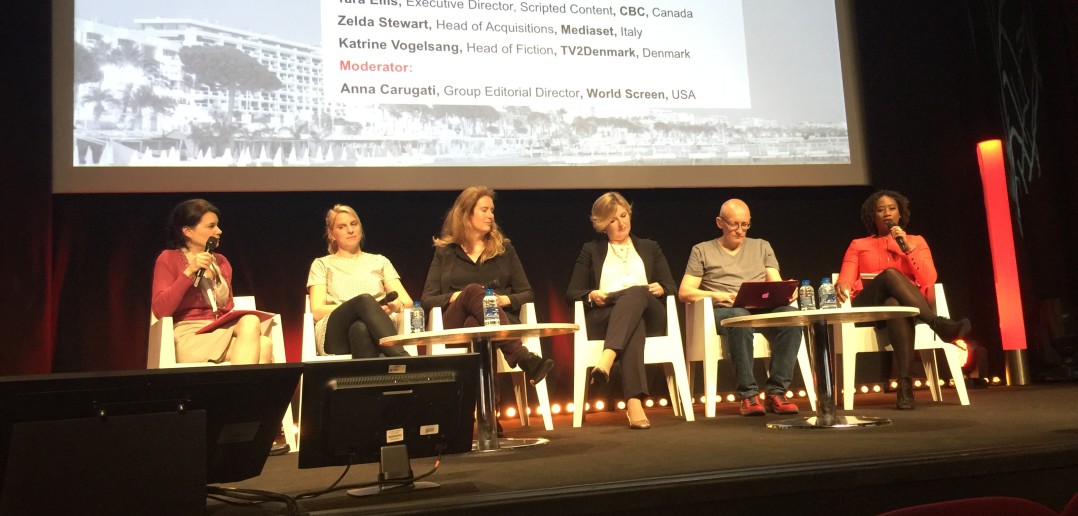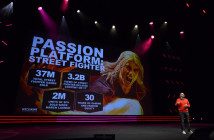Today’s MIPTV programme included the chance to hear from broadcasters about what they’re looking for in new drama acquisitions, as well as insight into the power of ‘live’ video-streaming and social chatter.
The Live: The New Cool in a Non-Linear World session dug in to the growing demand for live video streams online. Moderated by Bell Fund / FanTrust Entertainment board member/president Catherine Warren, the panel included Dan Biddle, director of broadcast partnerships at Twitter UK; Vigor Sörman, founder and CEO of Nordic multi-channel network Splay Networks; and Will Keenan, president of Streamup.
« For many fans there is no form of excitement more exciting than live entertainment. Live is where anything can happen. From the metaphorical train wrecks to the real moon landings, live keeps us glued to our seats, » said Warren as an introduction. « Live is raw, it’s right now, and it’s perceived as more real than the edited, packaged stuff that we also love so much. »
Sörman talked about Splay’s Unicorn.me platform, which helps digital stars from YouTube launch their own apps. One, Misslisibell, managed to get 60,000 fans to download her app, and is averaging 10,000 viewers and 25,000 chat messages for every livestream she runs within the app.
Biddle talked about how TV networks can use Periscope, Twitter’s live-video app. He suggested that « talent really drives conversation, and interaction« . In several countries, the stars of The Voice are Periscoping live before, after and even during shows, for example. « We’re also seeing comedians and drama stars… goggleboxing, » he said: they broadcast themselves on Periscope watching the show they were in, and talk to fans about it. « It’s an amazing way to put the audience into the palm of your hand, » said Biddle.
Is there advertising on Periscope? « At the moment we haven’t seen that, there’s no model for that at the moment. In theory if you were standing in front of a board that had advertising on it, like Match of the Day, you could do that, » said Biddle.
Sörman talked about the appeal of live for creators: YouTubers can find editing the « perfect » content for YouTube or Instagram quite stressful, whereas live is more raw and relaxed, whether it’s broadcasting live through their own app, or firing out short video clips through Snapchat.
Keenan was asked about original content on Streamup, and how important that might be. « A lot of the strong television formats and some of the strong online-video formats on YouTube can be done live: live reality shows, live beauty tutorials, live pranks, » he said. « If my reading of entertainment history is any indication, it’s a huge disruption… It’s becoming the new must-watch appointment-to-view television. »
He noted that while the viewership of reality television on traditional channels has been going down, the viewership of online vloggers has been going up. « While the reality shows became less real: scripted faux-reality… the video bloggers were looking into the camera and talking to people, and engaging with them in the comments. »
Sörman agreed: « Everything is really turning into live. People are looking for the content that is real, and what is more real than live? » he said. « This will drive the experience across all platforms. It needs to be video, it needs to be live. » Keenan noted that there have been live platforms before in the past, many of which were before their time. « It’s really to me the shared viewing experience and the interactivity and the chatting between the viewers that has made our platforms grow so fast. »
Keenan talked about how people make money: tip-jar donations are working well for creators. Brands are moving in to live video fast, he added. « Wherever the eyeballs go, the advertisers follow, » he said. Meanwhile, Sörman talked about how online influencers operate. « They see their audience like a family, where they really hang out with them. And the fans see the YouTubers or the influencers as their best friends. It’s why the branded entertainment deals with these influencers are so powerful: it’s your best friend who tells you to buy this car or whatever. »
Sörman talked about one young Swedish YouTuber’s recent near-live broadcast of something unusual: doing her housework. « She cleaned her room for one hour and 42 minutes. And this video got 1.5m views in Sweden out of a population of nine million!… And there’s now this YouTube tag where the kids are all cleaning their rooms. It’s good for parents! »
Keenan wrapped up: « The viewer is the new studio boss and the crowd is always right. There’s no more force-feeding content down the throats… or just doing something similar to a hit before. »

The Channels Talk session was moderated by World Screen’s group editorial director Anna Carugati, posing questions to a diverse panel of broadcasters about their drama strategies. “Drama has become addictive, people binge on it, they stay up too late at night!” said Carugati by way of introduction. “And drama has a unique capability to brand a channel.”
The panel included: Katrine Vogelsang, head of fiction at TV2 Denmark; Tara Ellis, executive director, scripted content at CBC in Canada; Zelda Stewart, head of acquisitions at Mediaset in Italy; Chmiel Maciej, TVP 2 channel director at Telewizja Polska in Poland; and Sandra Coulibaly, RTI distribution manager at Radiodiffusion Télévision Ivoirienne in the Ivory Coast.
The discussion kicked off with a debate about long-running series versus one-offs and special events. « We have a combination of all of those things, » said Ellis. « It really is led by the creative and by the story for us. » Coulibaly said that in the Ivory Coast, audiences are looking for long-running series. « They like to have a permanent appointment, every day or every week, for six months, » she said. « For us, long-running series is what we are really trying to do. »
Meanwhile Stewart said Mediaset’s long-running soaps are key appointments to view too. « On the production side it’s really important because a long-running series gives you a branding, an identity for your channels. » But TV2 Denmark has changed its strategy from focusing purely on long-running shows to try more one-offs. « We found that the audience kind of liked it. It was not ‘another long-running drama’ that was going to be for many years, » said Vogelsang.
How are the broadcasters financing their drama output? Coulibaly said that RTI prefers coproductions. « Generally, we finance in average 50% of the production budget. Sometimes we even go to 100% when the project seems to have a good potential for us, and it seems that the show has an international potential, » she said. Ellis said CBC does one or two coproductions a year « to tell a story that we couldn’t tell as a purely indigenous Canadian show, and quite frankly it opens up the budget as well » – as well as opening up new talent and locations.
Vogelsang said that TV2Denmark uses coproduction as its standard model, often within Scandinavia. « I’m looking mainly to see if it’s possible to coproduce with countries we have something in common with, where it makes sense to find the right story, » she said. Meanwhile, Mediaset returned to coproduction in 2015. « There are still quite a few great stories that still have to be told, » said Stewart. Chmiel talked about the approach to coproduction in Poland, where Telewizja Polska is the leading producer of Polish TV dramas. « We are concentrated on looking for some new ideas, but we have to preserve all those series which are already on the air, and which prove that we selected them well, » he said. Both Telewizja Polska and CBC work heavily with independent producers in their home countries, while taking the « driving seat » in coproductions.
Stewart said that for now, Mediaset is not making different drama for different platforms – it runs free, pay-TV and SVOD networks. « We’re looking for as broad a project as possible when we’re producing or coproducing, » she said. But what topics are the broadcasters looking to explore? « I would like to have the big romance back on television, » said Vogelsang. « It’s not long-running, because when they get each other the story is over. But a big big love story: that’s on the list. And the big European royalty, all the big houses, that would be a good story as well… but it’s a big, big drama and I don’t know who’s doing to do it. »
Meanwhile Chmiel joked that he is looking for a « futuristic sitcom » set in 2050, kicking off with a World Cup final « where Poland beats Brazil 7-0, and the family watching then gets their German waiter to make the food… and the other Westerners are coming to Poland searching for a better life! » Coulibaly is looking for a historical show in 2017 for RTI, meanwhile.
The broadcasters talked about acquisitions. Vogelsang says it’s difficult to make it work: acquired dramas tend to work « okay, but not brilliant » on TV2Denmark’s main channel. « But we’d really like it to work, » she said. « The quality of drama from all countries is so high at the moment, so I would really like the Danish viewers to see it. » Coulibaly said RTI still acquires almost 70% of the drama scheduled on its channels, while Stewart said Mediaset acquires over 1,000 hours of drama series a year – from the likes of Warner Bros and Universal in the US. « Then we also acquire a lot from all over Europe » – as far afield as Bulgaria and Turkey. « We have a very open mind: for almost all genres we have a channel or a platform that fits. »
The conversation also touched on procedural shows: Stewart and Vogelsang said their channels are both looking for more procedurals – shows where each episode is self-contained rather than contributing to a wider narrative arc – as acquisitions. « For the SVOD platforms procedurals work very well, » noted Vogelsang. « It’s difficult to find something that works on all the platforms. The local audience wants serialised, but as an acquisition, it’s episodic. » There is also a growing nostalgia among audiences for historical drama. « For the rose-coloured glasses reason, but also Canadians are fascinated by their history: maybe untold stories or small stories, » said Ellis of her country.
Are the broadcasters eyeing international potential when producing local dramas? « Yes of course, » said Coulibaly. « Everything I produce, my first objective is to sell. Obviously it has to air on the channel as well, but the main objective of coproducing is to sell internationally. » But Vogelsang said that « the more local we go, the better it travels… I’m a bit worried about all the distributors coming into the market wanting to be producers. There’s a tendency to try to figure out what they want, instead of having a big story… It’s not only to see ‘how can we put the finance together?’, it’s also about making a great show, and that’s what we need to keep the focus on. »




